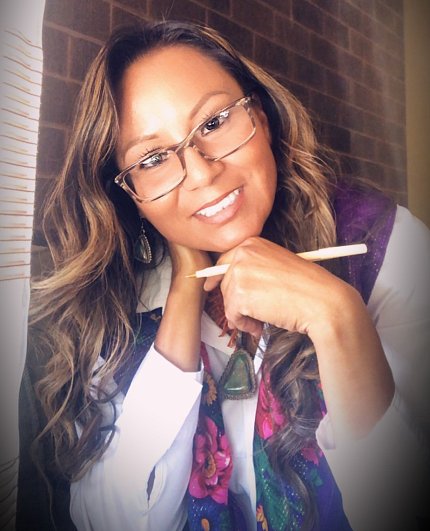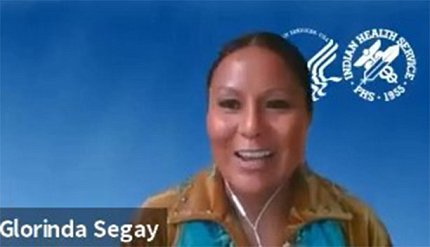Cloaked Crisis
Promoting Mental Health in Native American Communities

“Yá’át’ééh!” exclaimed Dr. Glorinda Segay, uttering a Navajo greeting to open her talk. Speaking at a recent NIMH Director’s Innovation Series lecture, Segay discussed her efforts to improve mental health services for American Indians and Alaska Natives.
As a therapist born and raised on a Navajo Reservation in Blue Canyon, Ariz., Segay is keenly aware of the unique needs of assisting these communities in culturally sensitive ways. As director of the Division of Behavioral Health (DBH) at the Indian Health Service, she works to ensure these communities receive needed mental health care.
“We coordinate national efforts to share knowledge and…develop and implement evidence-based, practice-based and culturally based activities across Indian country,” she said.
DBH oversees programs for alcohol and substance abuse and mental and behavioral health.
“Keep in mind that each community is different, so just because you hear American Indian or Native American doesn’t mean that all of us are the same,” said Segay. “We have different beliefs. We have different languages. Even our style of dressing is very different. Therefore, we have to be mindful about moving forward as far as what approaches [we use to] help.”
The Alcohol and Substance Abuse program (ASA) funds 12 youth treatment centers that provide holistic care to adolescents and families while integrating healing, spiritual values and cultural identification. Another effort is Preventing Alcohol-Related Deaths Through Social Detoxification.
ASA also works to prevent and treat opioid abuse, which is pervasive on Indian reservations. “It is a crisis across Indian country,” Segay said.
ASA staff collaborate with IHS’s HOPE (heroin, opioids and pain efforts) committee, a network of IHS doctors, nurses, clinicians, pharmacists and epidemiologists. In addition, working groups focus on finding new approaches to managing pain, improving access to opioid overdose reversal medication and reducing the impact of perinatal substance use on future generations.

DBH also offers a range of services to prevent mental, emotional and behavioral disorders and to intervene early and rehabilitate those who need help. One large effort offers emotional trauma care and trains providers in culturally sensitive trauma care.
“For our native people, a lot of us went through some sort of trauma,” said Segay. “We try to think about our people, what can we do, how can we help them, those who are victims and survivors. We talk to our partners at the tribal level. We use our behavioral health consultants at the local level. There are boots on the ground; they come to us and let us know [what’s happening].”
Another large mental health effort requiring cultural sensitivity is suicide prevention.
“We all have different customs. We have to be mindful of how we talk about suicide,” said Segay. “There is always a lot of robust, fast and fierce discussion trying to find a resolution and what is most effective.”
Initiatives include staff training and developing appropriate screening questions while strengthening data on suicide surveillance.
“In our upbringing, at least for me, there was no [discussion about suicide],” said Segay. “My parents kept us isolated. We used to live in the deep mountains, where we still live. We were cut off from the outside world. We only had a radio [with a signal only] to the local Navajo station, so we did not know about suicide.”
In training to become a provider, Segay learned about the cloaked crisis. “That’s where I started to see people do come forward,” she said. “They do ask for help.”

Photo: Shutterstock/Gary718
One way to deliver that help—which has been critical especially during the pandemic—has been tele-behavioral health, a growing effort across DBH to provide more convenient preventive, educational and treatment services to tribal communities.
In some areas, it’s not as easy. Navajo Nation, for example, has more than 400,000 members sprawled across a large land area, parts of which do not have broadband access. Where possible, telehealth has helped many on and off the reservations.
DBH’s Telebehavioral Health Center of Excellence has 436 programs, offering direct, ongoing care at 24 IHS-tribal-operated facilities across the country. Services include psychiatry, medication management and therapy and counseling services for children, adults, couples and seniors. Health care providers can tune in to a variety of TeleECHO clinics for on-demand training and webinars on such topics as autism and pediatric immunization.
Another focus of DBH is integrating behavioral health with primary care. DBH’s Behavioral Health Initiative (BH2I) manages projects for substance abuse support and suicide and domestic violence prevention. A forensic health project was launched to address sexual violence and later expanded to include child and elder maltreatment.
By collaborating at the national, local and tribal levels, Segay aims to secure optimal services “so that our people can get the most effective, compassionate care moving forward, in the hopes they can recover and live a beautiful and healthy lifestyle.”
